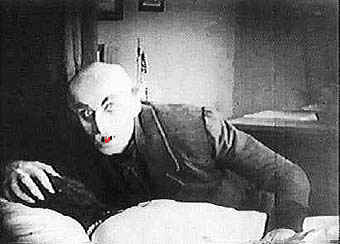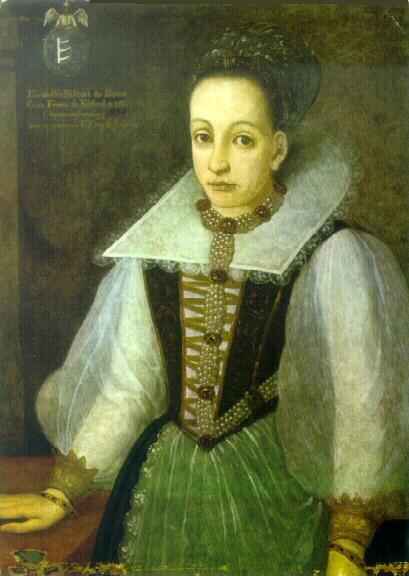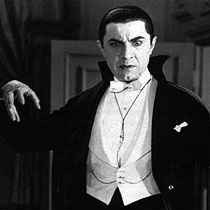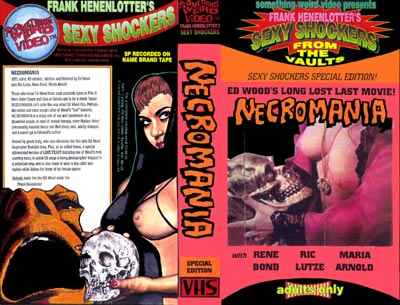|
Vampires We all hate cannibals, but for some inexplicable reason, everybody loves a vampire.
We all hate cannibals, but for some inexplicable reason, everybody loves a vampire. OK, maybe it's explicable. Vampires have a lot going for them. The eternal life thing is a big plus. And the wardrobe kicks ass. Super-powers, sleeping in, pointy teeth, sex appeal... Vampirism is a sexy thing, and the dismemberment of victims is strictly optional. Who wouldn't love it? Now granted, it's not all fun and games. You lose out on sunlight and silver jewelry. People have a tendency to try to impale you with wooden stakes, cut off your head and burn you to bits. And the currently documented number of vampires proven to have eternal life is zero, so you could be drinking all that blood for nothing. The practice of drinking blood goes back to the first time someone bled around someone else, with notable archaeological records supporting the notion found in Mexico, China and the Middle East, as well as more recent and documented practices in Africa and the South Pacific. Drinking blood almost always had a ritual or magical component attached to it (as opposed to cannibalism, which was often simply a dietary strategy in prehistoric times). There's just something about blood which speaks to the innermost human condition. Long before the days of DNA typing, blood was understood to be something very integral to identity. But the blood-rites of ancient religions aren't vampirism. The historical record suggests that the concept of the vampire as recreational blood-drinker/supernatural being dates back to around the time of Jesus Christ, who fueled the growth of such stories in very specific ways that people don't like to talk about. After all, two particularly notable aspects of the Jesus story are present in the vampire legend the concept of rising from one's grave, and the concept of drinking human blood in order to have eternal life: "He who eats My flesh and drinks My blood has eternal life, and I will raise him up on the last day. For My flesh is true food, and My blood is true drink. He who eats my flesh, and drinks my blood, dwells in me, and I in him."  Nothing ambiguous about that. The vampire as supernatural creature lingered for some time at the fringes of civilized consciousness, but it didn't emerge as a full-fledged category of its own until much later.
Nothing ambiguous about that. The vampire as supernatural creature lingered for some time at the fringes of civilized consciousness, but it didn't emerge as a full-fledged category of its own until much later. There were two threads of thought that combined into the modern conception of the vampire around the time of the Middle Ages. The first was the idea of the magical/healing properties of blood. Blood was thought to contain the magical essence of life, and it was widely used in various medical and occult practices. The second thread was the emergence of legends and rumors about the undead, soulless and unbaptized abominations who clawed their way from the grave to wreak havoc on the living. Around the same time, some of the first really gory documented tales of psychotic killers began to arise, such as the case of Sawney Bean, the leader of an incestuous cannibal tribe in Scotland, and the extremely lurid tale of Gilles de Rais, one of the first serial killers to immortalized in excruciating detail, who was convicted of Witchcraft, summoning Satan and other crimes. Later observers, such as Aleister Crowley, would conclude that de Rais was the victim of a politically motivated frame-up, however the list of charges and the content of the French nobleman's confession are so astonishing in their detail that it's hard to imagine there wasn't some grain of truth. According to the Inquisition, de Rais used the blood of the hundreds of children he had allegedly killed for alchemical experiments.
Vlad, who also went by the name Dracula, had the bad luck to see his father ousted from the throne of Walachia when he was just 17. Hungarian nationalists backed an invasion by Dracula, who captured the throne, lost it, went into exile, then captured it again much later. Once he was firmly in place, the fun stuff began. Vlad's excesses are chronicled elsewhere, but he was mostly famous for impaling. (Didn't see that coming, did you?) Vlad wasn't actually thought to be a vampire at the time, he was seen as more of a total bastard. The connection would come later, thanks to the turgid prose of Bram Stoker. However, the same region would play host to a more legitimate vampire about 100 years later Elizabeth Bathory. Bathory was a Hungarian noblewoman who enjoyed torturing her servants and took up an interest in the Black Arts. Legend has it she was beating a servant girl for some minor infraction when the girl's blood spilled on her arm. Bathory immediately determined that her skin had improved where the blood landed, so she had the girl bled to death and bathed in her blood. Although it seems unlikely, Bathory was convinced that this technique was making her young again, and she decided to keep it up. For about 10 years, she bathed in and drank the blood of kidnapped peasant girls on a regular basis. Eventually, her nobility was her downfall. She decided she needed a better quality of blood (possibly when her continued aging became too difficult to ignore), and started to prey on girls of noble birth. This obviously didn't sit well with the nobility, which ordered her arrested.
The Bathory case is perhaps the first real example of the fully formed notion of modern vampirism the idea that the blood of others will somehow provide eternal youth. The whole idea of the supernatural vampire didn't fully take form until Bram Stoker virtually created the concept in his novel, Dracula. Stoker was an Irish author in the 19th century. He wove together a series of legends and old wives tales concerning the undead to define the parameters of the modern vampire, including the aversions to silver, garlic, sunlight and the cross, sleeping in coffins and fangs. He attached the Dracula name to his story almost as an afterthought, and he knew virtually nothing about the historical Vlad. By modern literary standards, Dracula is virtually unreadable, its florid verbiage almost drowning the awesome visuals and chilling ideas, but it was still better than most popular fiction of that era, and it became a smash hit, sending chills down the spine of the repressed post-Victorian English and sparking a vast interest in all things vampiric. The story of Dracula grew by leaps and bounds, and vampires quickly became a staple of Western culture, boosted to warp speed by the introduction of cinema. One of the earliest and most influential movies of the silent era was Nosferatu, an "adaptation" of the Dracula story which was sufficiently adapted for Stoker's estate to successfully sue for copyright infringement.
Despite the fact that most of what is considered "vampire lore" was completely fabricated by Stoker, the idea of the vampire enflamed the popular mind to the point that people really started to a) believe in them and b) want to meet one, for purposes of sexual titillation and eternal life. When Anne Rice penned an insanely popular series of first-person vampire novels beginning in the 1970s, hordes of goth teens and even otherwise non-impressionable adults fell in love with the idea of vampires all over again. Many found Rice's vision compelling and convincing, and some strongly believed her characters were either real or based on some sort of reality. Rice has denied this, but when you look at her house and her wardrobe, it's kind of hard to buy the idea that she's a skeptic. Anne Rice's detailed historical novels also prompted a lot of revisionist vampire lore, as hundreds of thousands of impressionable teens went to college and learned the deadly art of misusing research. Pretty soon you couldn't swing an undead cat without hitting some historical "evidence" of vampires in ancient times. With the patent difficulties involved in finding actual vampires from whom to receive the Dark Gifts, many would-be children of the night were left foundering and directionless until the Internet came along and saved them! One of the Internet's great strengths is the ability to unite small cliques of people who enjoy deviant behavior, which previously was very difficult owing to social stigma, laws concerning certain interstate activities and burning at the stake. Prior to the Web's emergence in the 1990s, there was a small underground club scene in large cities like New York and San Francisco in which people indulged in fetish-oriented blood-drinking.
The Web has also allowed the creation of Web sites made by people claiming to be supernatural-type vampires, but these sites rarely display the mastery of English grammar which one would expect from a preternaturally intelligent person who has lived for centuries, raising the uneasy suspicion in the minds of readers that maybe just maybe the site was created by a disturbed 14-year-old. A distinct subclass of vampire has also become fairly ubiquitous in modern occult circles and pop psychology. Known as "psychic vampires," the term refers to persons who suck spiritual, magical, psychic or psychological energy from their victims without drawing blood. While the odds are very good that you've personally met a few of those, as of this writing, no one has captured and publicly displayed a real, live vampire of the "hundreds-of-years-old, garlic-hating, cross-spitting, bat-summoning" variety. Should that change, we'll certainly let you know.
|
 The real legend of the vampire was born about the same time, over in good old Transylvania. Vlad Tepes, or as he is famously known,
The real legend of the vampire was born about the same time, over in good old Transylvania. Vlad Tepes, or as he is famously known,  More than 650 girls had fallen victim to her obsession with eternal youth (she was only 50 at the time of her arrest, although that was a whole different thing in the 17th Century than it is today). Her primary servants, the ones in charge of the bleeding, were sentenced to death, but it was considered gauche to try and execute nobles, so Elizabeth herself was never put on trial. She was confined to her castle for the remainder of her life, which ended up being four years.
More than 650 girls had fallen victim to her obsession with eternal youth (she was only 50 at the time of her arrest, although that was a whole different thing in the 17th Century than it is today). Her primary servants, the ones in charge of the bleeding, were sentenced to death, but it was considered gauche to try and execute nobles, so Elizabeth herself was never put on trial. She was confined to her castle for the remainder of her life, which ended up being four years.  The official version of Dracula, released in 1931, launched Bela Lugosi on a starstudded career path that would end in heroin addiction and Ed Wood movies. It did more for the urban legend than for its leading man, however, thrusting the concept of the vampire firmly into the forefront of popular thought, where it has stayed ever since.
The official version of Dracula, released in 1931, launched Bela Lugosi on a starstudded career path that would end in heroin addiction and Ed Wood movies. It did more for the urban legend than for its leading man, however, thrusting the concept of the vampire firmly into the forefront of popular thought, where it has stayed ever since. With the advent of the Web, just about anyone who had ever thought about drinking blood could easily find and talk to anyone else who had ever thought about drinking blood. There are dozens of Web sites with tips on how to hygenically drink the blood of others, ettiquette in soliciting blood, and safety tips to help avoid piercing major arteries and otherwise killing the person you're playing with.
With the advent of the Web, just about anyone who had ever thought about drinking blood could easily find and talk to anyone else who had ever thought about drinking blood. There are dozens of Web sites with tips on how to hygenically drink the blood of others, ettiquette in soliciting blood, and safety tips to help avoid piercing major arteries and otherwise killing the person you're playing with.